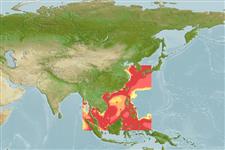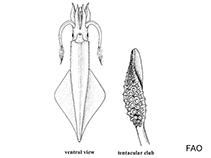Loliolus beka (Sasaki, 1929)
Beka squid| Native range | All suitable habitat | Point map | Year 2050 |

|
| This map was computer-generated and has not yet been reviewed. |
| Loliolus beka AquaMaps Data sources: GBIF OBIS |
Upload your photos
Google image | No image available for this species;
drawing shows typical species in Loliginidae.
Google image | No image available for this species;
drawing shows typical species in Loliginidae.
Classification / Names Common names | Synonyms | CoL | ITIS | WoRMS
| Myopsida | Loliginidae
Environment: milieu / climate zone / depth range / distribution range पारिस्थितिकी
पिलाजिक; गैर प्रवासी (Ref. 75927), usually 60 - ? m (Ref. 75927). Tropical; 38°N - 1°S, 94°E - 135°E (Ref. 97142)
वितरण देश | ऐफ ऐ ओ क्षेत्र | Ecosystems | संयोग | भूमिका
Indo-West Pacific: From Japan and South Korea to Hainan Island, the Gulf of Thailand and the Andaman Sea. Tropical to temperate.
Length at first maturity / आकार / वज़न / Age
Maturity: Lm ? range ? - ? cm Max length : 7.0 cm ML पुल्लिंग / अलिंग; (Ref. 75927)
Depth distribution is undetermined. Found in coastal and estuarine areas, specifically in bays (Ref. 97142).
Life cycle and mating behavior परिपक्व अवधि | पुनरुत्पत्ति | मछलीऔ का अंडे देना | अंडे | Fecundity | लार्वा
Members of the class Cephalopoda are gonochoric. Male and female adults usually die shortly after spawning and brooding, respectively. Mating behavior: Males perform various displays to attract potential females for copulation. During copulation, male grasp the female and inserts the hectocotylus into the female's mantle cavity where fertilization usually occurs. Life cycle: Embryos hatch into planktonic stage and live for some time before they grow larger and take up a benthic existence as adults.
Main reference
संदर्भ | संयोजक | सहयोगीयो
Roper, C.F.E., M.J. Sweeney and C.E. Nauen. 1984. (Ref. 275)
IUCN Red List Status (Ref. 130435)
Data deficient (DD) ; Date assessed: 01 July 2015
CITES status (Ref. 108899)
Not Evaluated
CMS (Ref. 116361)
Not Evaluated
Threat to humans
Human uses
| FishSource |
साधन
अधिक जानकारी
इंटरनेट स्रोत
BHL | BOLD Systems | CISTI | DiscoverLife | FAO(Publication : search) | Fishipedia | GenBank (genome, nucleotide) | GloBI | Gomexsi | Google Books | Google Scholar | Google | PubMed | Tree of Life | Wikipedia (Go, खोज) | Zoological Record
Estimates based on models
Preferred temperature
(Ref. 115969): 7.9 - 18.3, mean 11 (based on 60 cells).



